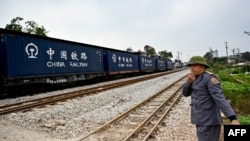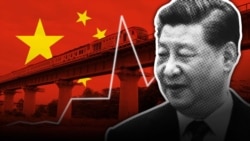Analysts are pointing to management and funding issues for Vietnam’s planned north-south, high-speed rail initiative and express concerns over potential “debt traps” and growing Chinese influence as Beijing funds a railway connecting the two countries.
The comments come as Vietnam is expanding its infrastructure by building railways using Chinese and Vietnamese funding, projects that could help the country’s outlook in the long term. As part of the effort, Vietnam’s National Assembly on Feb. 19 gave near-unanimous approval to legislation allowing the country to use Chinese loans for a new $8.3 billion rail link from the port city of Haiphong to China.
Nguyen Hong Minh, then the transport minister, announced Vietnam’s plans to use the Chinese loans for the 391-kilometer passenger and freight line from Lao Cai on the Chinese border and passing through Hanoi.
"Vietnam's current railway system is outdated, and the country needs a new system to support its economic development," Minh, now the construction minister, said, adding that construction is expected to begin this year and be completed by 2030.
The National Assembly vote followed its November approval of construction of a high-speed railway connecting Hanoi to the country's southern economic hub, Ho Chi Minh City. That project is Vietnam's most ambitious infrastructure initiative to date and is projected to cost Vietnam $67 billion. Authorities said construction should begin in 2027 and be completed by 2035.
Ha Hoang Hop, chair of the Hanoi-based Think Tank Viet Know, told VOA on Feb. 17 that while both projects could modernize the country's transport network and improve its economy, “public sentiment is cautious.”
“There have been several publicly funded railway and infrastructure projects in Vietnam that have led to public frustration due to delays, cost overruns and poor-quality outcomes,” Hop said.
“Public skepticism is also fueled by fears of debt traps associated with Chinese loans,” he said.
Hop cited fear the construction of the high-speed rail project could be dogged by the country's “historical issues with project management and corruption.”
“There is indeed concern that the north-south, high-speed rail could face similar challenges given the scale and complexity of the project,” Hop said.
Mismanagement and corruption
Albert Tan, associate professor at the Asian Institute of Management in Manila, told VOA on Feb. 18 that while Vietnam's railway modernization will improve the country's supply chain efficiency, the major problem is corruption.
“The corruption level in Vietnam is so high that when you have that amount of money that the Chinese are pumping in, I'm sure there will always be leakages,” he said.
Tan said railway funds ending up in “someone's pocket” have caused delays and cost overruns for Vietnam's two city Metro lines. In 2021, the Chinese-funded Cat Linh-Ha Dong Metro line began running in Hanoi, five years behind its originally planned opening. The first line of the Ho Chi Minh City Metro, primarily funded by Japan, opened in December 2024, six years behind schedule. Costs ballooned for both Metro lines while under construction and delayed payments to contractors slowed the process.
“Somehow the money doesn't go back to the contractor. Money goes somewhere to other stakeholders,” Tan said.
For the north-south, high-speed rail, Hop said the country is planning to rely on domestic funding with capital likely to come in the form of “government bonds, public investment and possibly some low-interest loans.”
“A $67 billion project will still be a significant challenge requiring careful financial management,” Hop said.
Chinese influence
Hanoi's decision to pursue domestic funding for its high-speed rail shows the country's drive to “maintain strategic autonomy,” Hop said. As it looks to Chinese loans for another rail project, though, “there remains a significant portion of the populace wary of increasing economic dependency on China,” he added.
Tran Anh Quan, a Vietnamese social activist currently living in exile, told VOA on Feb. 18 he fears the Chinese-funded railway will leave Hanoi indebted to Beijing and could be a weak point if conflict were to break out between the countries.
“This is definitely a debt trap,” he said. “Expanding the railway to China would be very dangerous if China attacked Vietnam.”
Tan also shared concerns over the "one-way" flow of money. He said the Chinese loans are likely to be paid to Chinese firms that will “retain control over construction and maintenance, with little technology transfer to local engineers.”
Joshua Kurlantzick, senior fellow for Southeast Asia and South Asia at the Council on Foreign Relations, told VOA that Chinese influence in the region is already “massive.” He said Chinese funding for the Vietnamese railway is in line with Beijing's goal to expand its influence in Southeast Asia.
The railway “fits right into China’s efforts to link the Mekong region, and to connect them to China,” he wrote in an email.
Kurlantzick said that in Vietnam's delicate balancing act between Washington and Beijing, China is taking the upper hand as he sees U.S. influence waning with the withdrawal of funding to Vietnam through USAID and weakening public diplomacy more broadly.
“China is by far the dominant economic power in Southeast Asia already, increasingly the dominant security power, and now, with the U.S. giving up its soft power in the region, China will increasingly bolster its soft power in the region, too, making it even more dominant,” Kurlantzick said.
Minh Son To, a research assistant focused on Vietnamese and Chinese politics at Singapore’s Nanyang Technological University, told VOA February 20 Hanoi has looked to Laos with concern after a China-funded high-speed rail threw the country into an “existential debt crisis.” Still, he said many are eager to see Vietnam develop.
“Any 'China' label is bound to evoke some concern, though I wouldn't overstate that,” he told VOA. “Vietnamese know that they need development and infrastructure, regardless of where it comes from.”







